Non-profits need to effectively convey their impact to justify funding and attract donations.
Context
We work with many of the UK’s leading purpose-driven organisations, charities and foundations, and over the years we’ve learnt a thing or two about how to use your website's design to get across your organisation’s impact. It’s a complex challenge, but we like to make things simple, so in this article, we’re going to focus on two of the most effective ways you can convey your impact: stats and stories.
Mission vs Impact
Before we get started, it’s important to define some key terms.
Your mission is the reason your organisation exists. It should be a succinct explanation of what you do. Cancer Research UK’s mission statement is a great example of this: “Our mission is to prevent, control and cure cancer through our ground-breaking research”. It gets across in one sentence what they exist to do, and how they’re trying to achieve it.
Your impact is how you’ll demonstrate your success in achieving your mission. It’s how you back up those big claims and prove that your work brings your mission a step closer to reality.
Using stats to convey your impact
Using a big statistic can be a highly effective way of conveying impact. The beauty of a well-selected statistic is that it imparts a lot of information incredibly quickly.
Anthony Nolan, the stem cell donor charity, uses a single powerful stat ‘One million united to change lives’ as the hero copy on their homepage. This helps to capture the scale of the impact they have and provides social proof for those considering joining their stem-cell register, making subsequent calls to action more likely to be effective.
Water Aid also utilises big stats on their home page, in a section called ‘What we achieved together in 2023’. Stats like ‘6,682 schools with clean water’ show potential donors that their contributions could make a massive impact.
Use fewer, better stats
When using stats, it’s important to avoid information overload. A single clear and powerful statistic should be given the emphasis it deserves. Adding five more stats might distract from its impact because it’s no longer the focus.
Persuasion theory suggests that a single strong argument for why something is the case is more effective than the same strong argument presented alongside several weaker arguments. This may be due to cognitive load theory, which predicts that when presented with too much information our ability to process it decreases. This means a few or even just one highly impactful stat can be far more effective at conveying your impact than using several stats at once.
When to use stats
Some audiences are more receptive to stats than others, so you should tailor your use of stats to the needs of your audience. Some charities have a wide donor base that attracts large numbers of small donations from the public. These donors are not typically experts in the charity's cause but want to contribute to something positive.
When engaging the public, you should choose your stats carefully. Too many stats can be off-putting, especially if they use complex terminology and stats should focus on ends, not means. This means focussing on the outcome of your mission on real people or causes, rather than looking inwardly at internal metrics.
If your focus is the general public, it’s far more effective to use stats that show the impact that funding has on end recipients, like ‘X many lives saved, X many people trained, X many warm meals served’ or whatever end goal your charity has, rather than focusing on means like amount of grants awarded, like the example below.
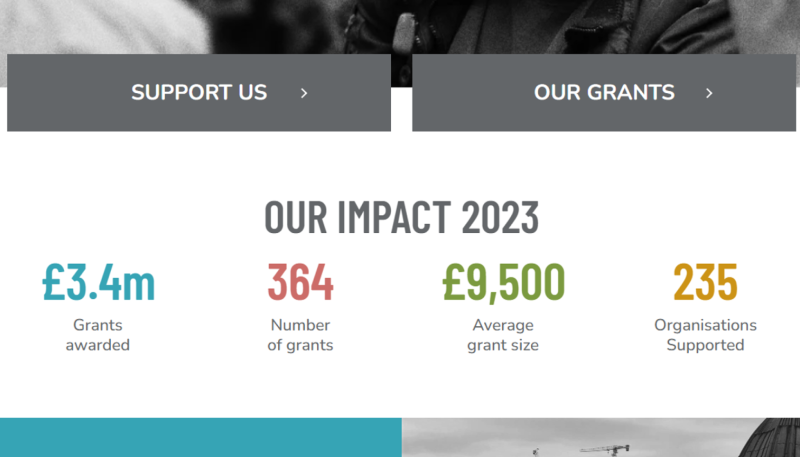
The example from Water Aid below shows stats that focus on the end outcomes of donations for real people.
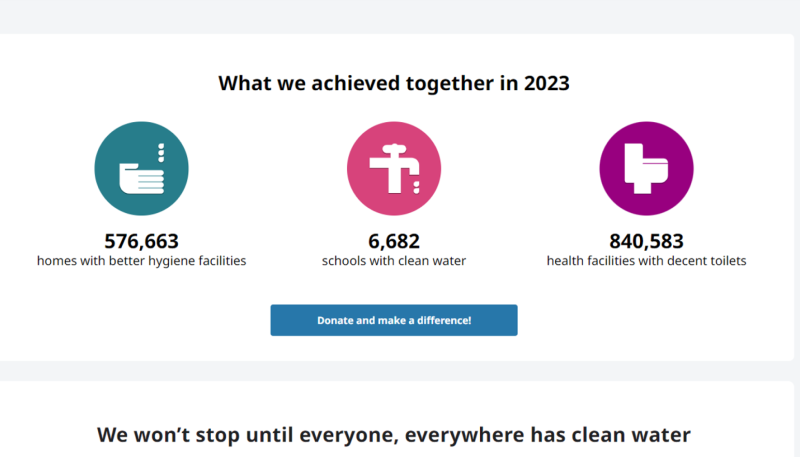
It can also be great to contextualise your stats and show users what their donation will fund, such as this interactive donation panel from Solar Aid.
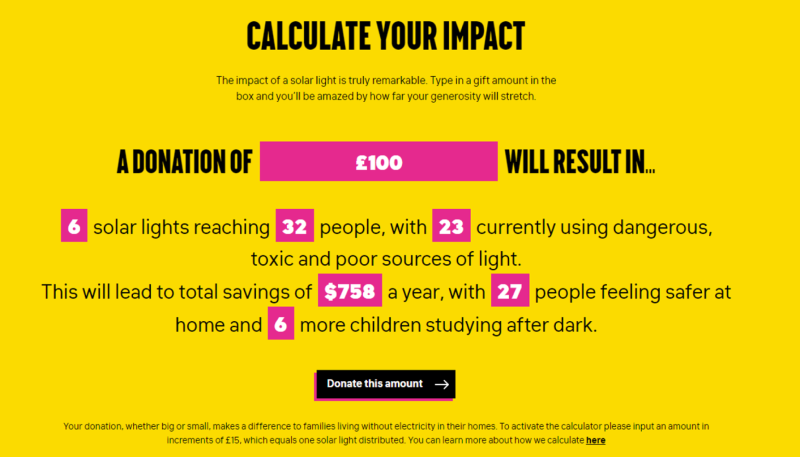
If your target audience is larger institutional donors, you can use stats more frequently. As experts in their field, they’ll be far more familiar with the complexities of your sector and better able to interpret statistics. However, it’s still important to be selective and to design your website to ensure those stats stand out effectively.
Design stats to stand out
Big stats are great, but how they’re presented visually is just as important. Your stats should jump off the page as a key focal point of the design, otherwise, they’ll fall flat no matter how impressive they are. Take the example of the homepage of Save the Children below. This section contains several important stats:
- Save the Children operates in 115 countries
- They help thousands with access to clean water
- They work with 2.9 million children on distance learning
- They’ve helped 10,000 of Britain's poorest children with essentials.
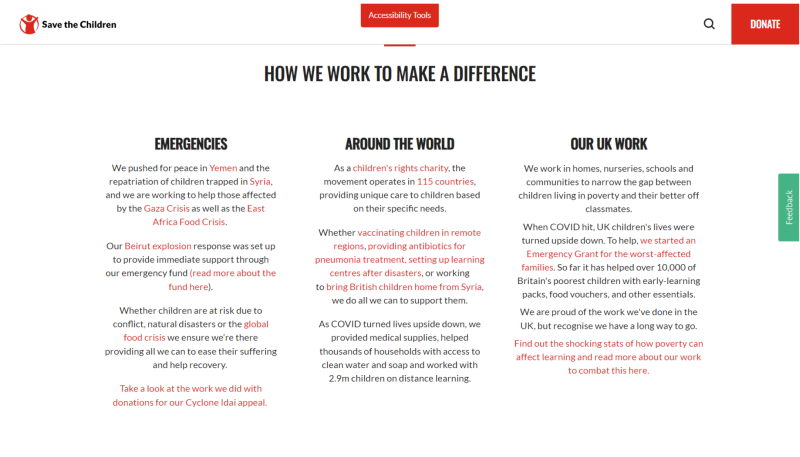
But as powerful as these stats are, they don’t stand out and so fail to make an impact on the reader. Presenting them in paragraphs of copy means they get lost, and a user is likely to miss them.
Contrast this with a similar section on Concern Worldwide’s website, which picks just three key stats and highlights them effectively through simple, clean design. A user is far more likely to notice them.

Subtle micro-animations and integrating how you present your stats into the site’s motion language can also help to draw attention to key information and make lasting impressions. Even a simple animation such as appearing on scroll draws the user's eye and therefore helps to emphasise a stat’s importance, such as on the World Risk Poll by Lloyds Register Foundation.
Using stories to convey your impact
While statistics provide a quick and powerful way to demonstrate impact, stories resonate on a deeper, more emotional level. They humanise your organisation's work and connect with your audience in a meaningful way, putting a human face to the impact you have.
Stories require more context than statistics, making them ideal for use deeper within your website. By sharing personal narratives, you can let the people impacted speak for themselves, helping to build trust by letting users hear from real people rather than faceless organisations.
The website we designed for the Children’s Society is a great example of how charities can use stories to communicate their impact.
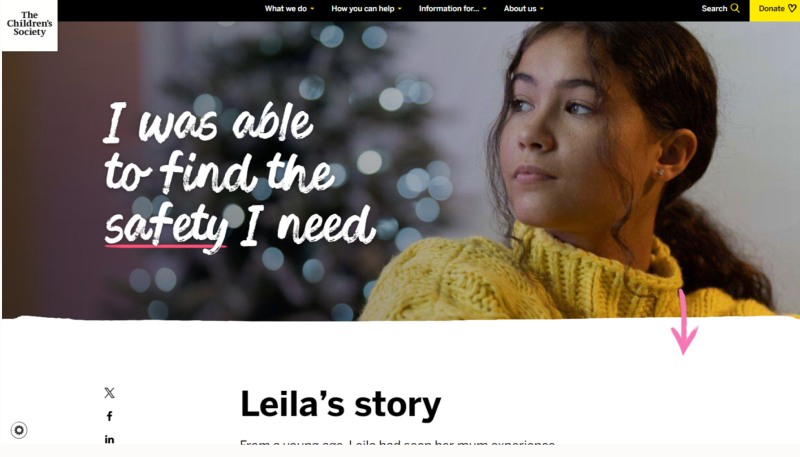
Story pages focus on a single individual, stepping users through a narrative that explains the compelling need for the charity’s work, and how it changes lives. This establishes an emotional connection, engaging users and making them far more likely to take a subsequent action, such as donating.
Stories can also serve as effective "hooks" to draw visitors deeper into your site. A teaser like "Hear Sam's Story" can pique curiosity and encourage users to click through to learn more. This approach can be particularly effective on your homepage or in email campaigns, enticing people to explore further and engage more deeply with your cause.
Designing for storytelling
From a design perspective, story content provides an excellent opportunity to stretch your creative muscles and fully utilise your brand elements. Because you want to take users on a journey through a narrative, stories allow for a richer, more immersive design approach.
Consider incorporating elements such as:
- Large, emotive images
- Pullout quotes to highlight powerful statements
- Videos to bring stories to life
- Animations or motion that guide users through the story.
For the Children Society’s story pages, we utilised strong imagery, animated arrows to step users through the story, and a hand-written style of typography for quotes that makes them feel more personal.
Effective storytelling techniques
When writing your stories, make sure they tie back to your mission statement and core values. Each narrative should not only showcase your impact but also reinforce what your organisation stands for.
Here are our tips for effective storytelling:
- Be authentic: Use real stories and attribute them. Authenticity builds trust and credibility. Quotes without a name & face behind them don’t have the same power.
- Focus on transformation: Highlight the change that occurred due to your organization's intervention.
- Use multimedia: Incorporate photos, videos, or audio clips to make stories more engaging and immersive.
- Keep it concise: While stories allow for more detail than statistics, avoid overwhelming your audience. Aim for impactful, focused narratives.
- Include a call to action: After engaging your audience with a powerful story, guide them towards taking action, whether that's donating, volunteering, or sharing the story.
Conclusion
Both statistics and stories play crucial roles in conveying your charity's impact through your website. While stats offer quick, powerful snapshots of your work, stories provide the emotional resonance that can truly move your audience. By skilfully combining both approaches and presenting them through thoughtful design, you can effectively convey your organization's impact in a way that engages donors, volunteers, and supporters alike.
To make your website more effective at conveying your impact, see our design and user experience service.